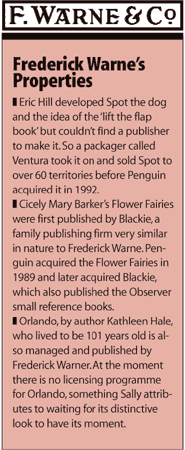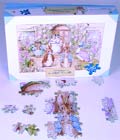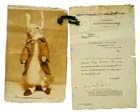]> Without books, the world would be culturally and educationally the poorer. Books are where many of our best loved cultural icons are born. They are the foundatio
April 6, 2018

]>

Without books, the world would be culturally and educationally the poorer. Books are where many of our best loved cultural icons are born. They are the foundation stones of learning and communication. They also have a potency that makes them essential companions in contemporary cultural life, whatever your taste. 
It follows that publishing is one of the most important ingredients in the licensing mix. As a licensor an author or publisher can create intellectual properties as famous as Winnie the Pooh and Harry Potter. As a licensee a publishing company can give an entertainment property valuable authenticity and form the basis of its licensing pyramid.
The position of acting as both licensor and licensee is exactly the position Sally Floyer finds herself in. For twenty years she has managed some of the world's most enduring properties as managing director of Frederick Warne. Since 2002 she has also been managing director of Ladybird, the international book brand most famous for its board covers and now aiming to be the top destination for licensors seeking a publishing licensee partner. Sally's daily objectives combine an acute concern for the bottom line with a vision that must keep the classic brands fresh without harming their heritage. She says, 'Entertainment is learning. And learning without entertainment is impossible.'
At the moment, children's book publishing is enjoying huge success. As well as being a highly lucrative concern it is supported by UK education policy and Government initiatives such as Bookstart and the year of literacy. One of the first publishers to recognise the importance of children's publishing was Penguin, under the guidance of its founding managing director Allen Lane.
The publishing company Frederick Warne, which owned the rights to Beatrix Potter's books, was acquired by Penguin in 1983. Its story is typical of the huge changes that affected the publishing industry in the 1980s. Broadly speaking, until the 1980s paperback publishers like Penguin purchased paperback rights from hardback publishers that were also the rights owners. Penguin therefore rarely owned anything other than very specific rights to the books it published. Managing director Peter Mayer was one of the first to see that for future survival, Penguin must start to own its own intellectual properties from cradle to grave.
Sally takes up the story, 'As the publishing industry became more competitive small companies found it hard to survive and even harder to manage the brands they owned. Penguin acquired Frederick Warne in 1983 and, with it, the rights to the Beatrix Potter stories, for which Warne was already implementing a strategy of management and extension. At the time of the acquisition, licensing agency Copyrights and forty or so licensees were already on board.'
The development of Peter Rabbit, the world famous character created by Beatrix Potter over one hundred years ago, has echoed the significant developments in both the publishing and licensing industries in the last twenty years. Sally says, 'Through the 1980s we built on the base of forty licensees by licensing into new product categories. But by the late 1980s the number and popularity of children's characters had grown and licensing had shifted up a gear. At this time, for example, Disney was producing a new film and merchandising campaign ever year. As a result, classic properties like Peter Rabbit had to compete in a much busier licensing arena.'
Since then, Warne has had to stay at the forefront of change to keep Peter Rabbit on the radar of licensees and retailers.
Peter Rabbit
Sally was attracted to work at Warne because she knew the appeal of Beatrix Potter. The aim of Frederick Warne within Penguin was to acquire and managed wholly owned brands. Its portfolio also contains Spot, Flower Fairies and Orlando (for which there is no merchandising programme at the moment). The door is open for new brands, though it can prove hard to come across them, especially ones with publishing rights intact. 

Peter Rabbit is one of the jewels in Penguin's crown. There are 24 pages of Peter Rabbit books in the Warne catalogue, for example, displaying many variations on the one theme. It's important to remember that there are many channels of distribution for books including clubs, direct sales and the gift market, so books are made specifically for each one. 'The children's book market refreshes every year because there are new children all the time. So existing titles, or the back catalogue just keep going,' Sally says.
The market in the Far East has always been important for Beatrix Potter and, particularly, Peter Rabbit. Things started in Japan where the first books were published in 1971 and the first licensees signed in 1976 for banking and for mayonnaise. Sally recalls a meeting with a Japanese lawyer who used Peter Rabbit stationery throughout. In fact this wasn't flattery but genuine purchasing interest from the young woman. She was typical of the adult female customer that liked to visit the places featured in Potter's stories and acquire objects relating to them. Those customers are now parents and the emphasis of Peter Rabbit licensing has shifted from adult to child products. 
Managing a world classic
Keeping a classic property fresh is the mantra of licensors charged with managing classic brands. Sally's team has devoted twenty years to the job and she says that having so few properties in the Warne portfolio actually means the focus on them just gets sharper. 'I have to find Peter Rabbit endlessley fascinating. It would be tempting to start new things, like merchandising for Orlando, but we are waiting until its highly stylised look has it's moment. And we are sure that it will.'
Sally points to a number of tools and lessons that have been learnt in keeping the properties fresh. 'I think there are two things we've learnt. Firstly to always think ahead as far as trends are concerned. We ask what the outside world is doing, wearing, thinking, and what are the trends influencing it. We want to present classic characters in a way that is relevant to a contemporary audience.' She cites the Peter Rabbit Seedlings look as a good example of this. The look was created in response to the way the children's clothing market has changed and its effect was to free-up licensees to think of Peter Rabbit in a different way.
She adds, 'Secondly, over time, you understand more about the effect your property has on its audience. For example, we have discovered that Spot is very good at helping children through basic new experiences, such as going to the doctor. We can respond to this.' 
The Frederick Warne archive, which contains approximately ten thousand items relating to Beatrix Potter, also comes into play. At the moment Warne is helping an author tell the story of Beatrix Potter, the scientist. Warne also uses hooks to make the Potter characters important, such as the anniversary of the letter by Beatrix Potter that was the inspiration for the stories and, later, the anniversary of the first publication of Peter Rabbit. It made new reproductions from the original drawings for the 100th anniversary and was among the first licensors to produce a digital style guide for licensees.
Does Sally ever feel more like a heritage curator than a commercial publisher? 'Profit is very important,' she says. 'We have to have commercial success for these classic brands. But in terms of understanding and communicating the integrity of the properties and the purity of the ideas we are guardians of the brand, just as any brand manager is when faced with extending it. We know that Beatrix Potter herself always understood she was inviting people into her world and that this wasn't exploitative.'
It's for these reasons that Sally feels strongly that Warne's classic properties will thrive best where they are, within a big company like Penguin. 'Here the team can draw on the extensive in-house resources of a big company. Even more importantly, we maintain strong retail relationships in parallel with our licensees. That route to market is essential,' she says.
In 1990 Frederick Warne decided to make a series of half hour TV specials of Beatrix Potter stories using hand drawn animation. It was the last flowering of that detailed, hand-drawn look and yet the company worried about fans' perceptions. With some trepidation Sally invited the Beatrix Potter Society members to an early screening and was very relieved that they liked it very much. She certainly has plans to make animation again and think it will be aimed at very young children.
Ladybird
In 2002 Ladybird came into Sally's fold. Until the late 1980s Ladybird was synonymous with school and learning. But after the Net Book Agreement was scrapped and the mass market opened up for books it was decided that Ladybird should become a consumer series rather than an educational series. Since 1945, when its mini hardback programme was introduced, Ladybird has published between 100 and 250 titles each year. It is no stranger to licensing, being the Disney mass market book licensee in the UK.
Sally's aim is for Ladybird to make books for children at each stage of the whole spectrum of the UK pre-school curriculum. 'We are aiming to help children develop from babies into readers,' she says. She also wants Ladybird to become the destination of choice for licensors looking for publishing partners and says there are a number of reasons why Ladybird can be a good partner for rights owners. 'We understand about good content production and developing ideas. The Ladybird book for Finding Nemo, for example, has a cut out make your own fish tank section. We have a good route to market and we like to get under the skin of a property and we understand the apprehension that rights owners have, wondering how their property will translate into book form.'

Another aim is to mine the rich source of imagery in the Ladybird archive. Any-one owning a vintage Ladybird will know just how they hold up a mirror up to life in the 1960s, a retro look that is still popular.
Licensing and publishing
On the subject of licensed books, Sally has no doubt that books licensed from TV or film are not the poor relation of published books. She says, 'Books are the permanent reminder of the show itself. They are mobile (you can take them in the car, for example), they articulate the property and they are interactive, allowing children and parents to talk about the show rather than just watch it.'
Sally also feels passionately that books are not becoming ephemeral. 'Although they are available in more places and in more formats, you would discard a magazine but keep a book where the two might have similar cover prices. After the Net Book Agreement was disbanded books became subject to the same promotional abilities as other products and were distributed further afield. I don't think this is devaluing for books.' In fact, she suggests, the rise of book clubs and book sales seem to indicate that it has had the opposite effect.
Children's authors are not under pressure to create extendable properties, unlike their counterparts making TV for children. Sally says, 'It is still OK to write and produce a book that is only a book. There are thousands of titles published each year and only a tiny percentage of them extend beyond the page.'
Sally's hopes for the licensing industry relate to consumer discernment and quality. 'I'd like to see more genuine reasons for licensing agreements to exist,' she says. 'We should look for quality in the mixture of brands being licensed. The success of licensing in the long term lies in partners' ability to add value and enhance the consumer experience. It's the sum of the whole being greater than the sum of the individual parts.'
Sally would also like consumers to be more discriminating against products that don't genuinely add value. Warne market research indicates that this is increasingly the trend. 'The result of combining two brands should be enhancement of both products. I feel passionately that no-one should feel exploited. Not the rights owner nor the licensee nor, especially, the consumer.'
You May Also Like






